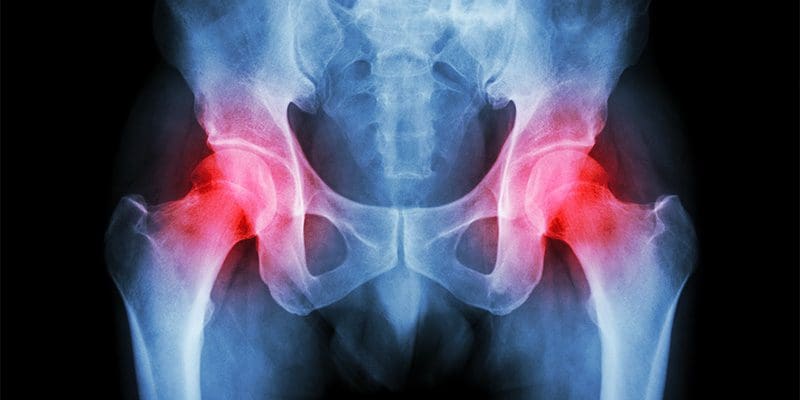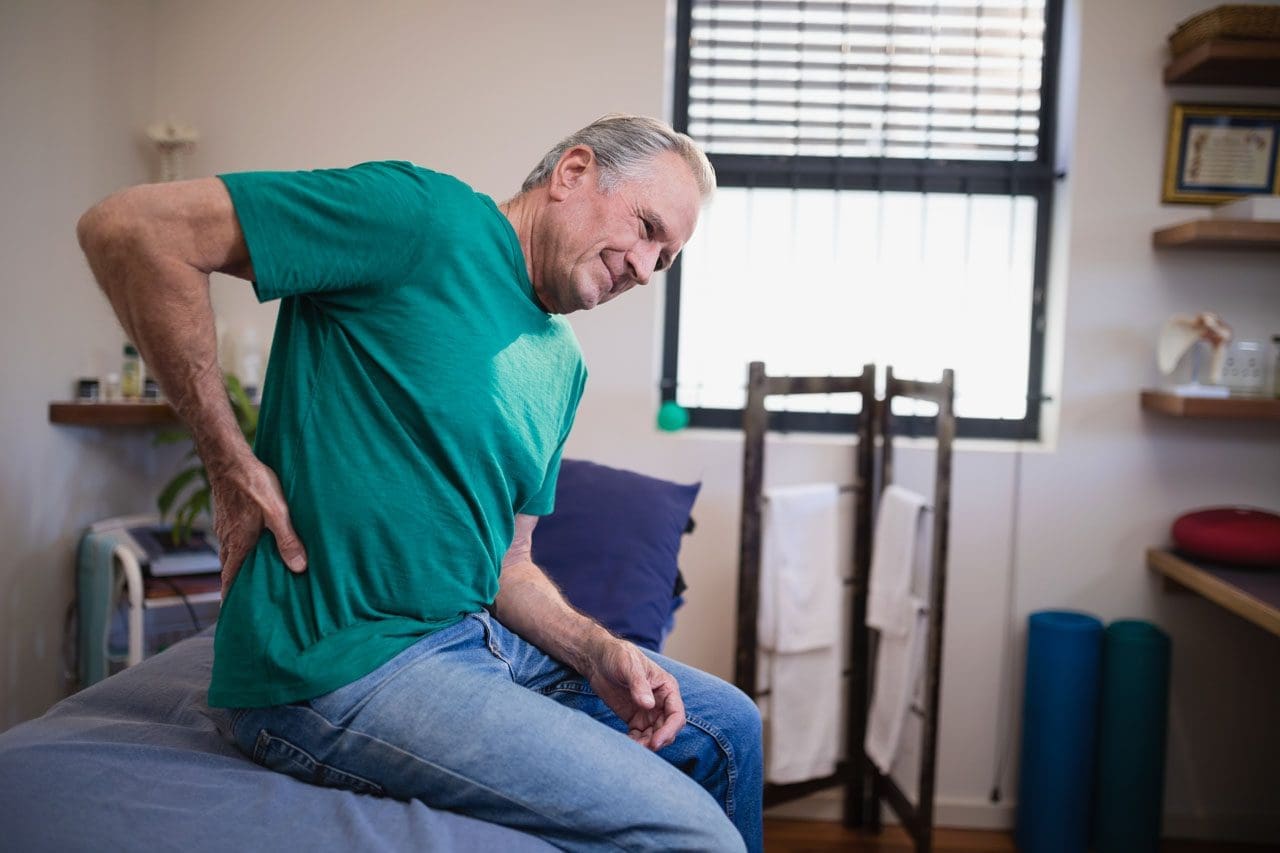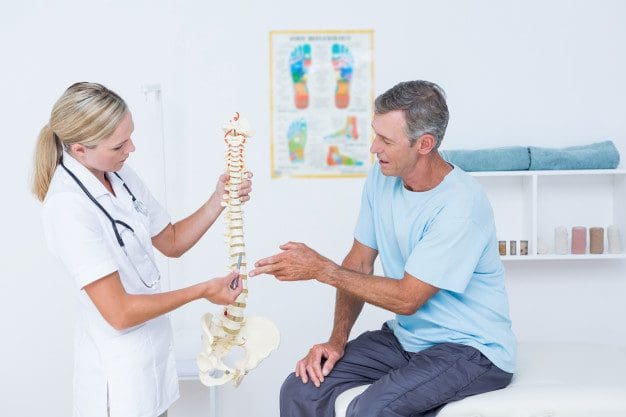Pain in the low back, hips, and other areas of the lower body, the source isn’t always easy to pinpoint.
Pain may originate in the lumbar spine (low back) the hip or both.
It’s important that a doctor identify the source of the problem, in order to create the correct treatment plan.
Because the hips and lower spine are located so close it can be easy to mistake back pain for hip pain the other way around.
Table of Contents
Most low back pain and hip pain share a common cause:
Normal wear and tear on the body due to aging or triggered by overuse injuries (possibly referred to as degeneration or degenerative changes).
- Lumbar sprains
- Strains
- Osteoarthritis
- Herniated discs
Are common degenerative culprits behind low back and hip pain.

Symptoms that the Hip Is the Root
One of the biggest symptoms that pain caused by a problem in the hip is groin pain.
The hip joint is located behind the groin, which is why groin pain typically means the hip is the root.
In some cases, the groin pain will radiate downward toward the knee.
Another symptom that the hip is the source is pain around or over the hip joint.
Hip problems can also refer pain to in the low back.
This is what causes confusion over where the true source of the pain.
Hip-related pain is most often caused by osteoarthritis in the hip.
Osteoarthritis in the hip can cause pain in the:
- Buttocks
- Front of the thighs
- Knees
Limping when walking and a reduced range of motion in the hips, along with pain that worsens with activity and improves with rest.
Osteoarthritis is the most common cause, hip pain can also come from:
- Piriformis syndrome
- Avascular necrosis in the hip
- Sacroiliac joint dysfunction
- Piriformis syndrome will cause dull, mild pain in the low back, and buttocks and can radiate down the leg.
- Hip pain attributed to avascular necrosis will be severe and constant.
- Sacroiliac joint pain could be attributed to the hip and the low back because the sacroiliac joints connect the sacrum in the spine to the hip bones.
Symptoms that the Spine Is the Root
Where groin pain is a sign that the pain is linked to the hip when the pain is above the waistline and travels down the body usually indicates a low back issue.
Among the most common degenerative conditions that affect the lumbar spine are:
- Herniated discs
- Spinal stenosis
- Spondylolisthesis
Pain is caused by irritating the low back nerves, which results in pain shooting down the leg/s and:
- Weakness
- Numbness
- Reduced range of motion
Arthritis of the spine brings on pain usually when first getting out of bed or rising up after sitting.
It usually improves after beginning to move.
Spinal stenosis or nerve pressure compression pain worsens with prolonged standing or walking, while relief comes with sitting.
Getting to the Root
When there is pain in the lower body and are not sure whether it’s the back or hip, the first course of action is to visit your doctor or a chiropractor.
They will review your medical history and perform a series of physical exams, such as various movements to get an idea of what is going on.
Your primary doctor may refer you to a doctor/chiropractor who specializes in hip or spinal conditions to make an accurate diagnosis.
The doctor will ask you to describe the:
- Pain
- Location
- When it worsens
- When it’s relieved
- What the pain feels like (e.g., sharp, dull).
The doctor may have you perform various movements to observe your biomechanics.
The goal is to determine what movements trigger the pain.
One such maneuver called the Flexion Abduction External Rotation (FABER) test helps determine if the pain is sourced in the hip and possible sacroiliac joint problems.
For this test, you lie on your back while flexing and rotating the hips.
The doctor will also palpate (press) the pain area.
The doctor may order image scans, like x-ray, MRI that can reveal the root of the spine or hip problem.
The Source
Treating Back Pain and Hip Pain
Once the pain is identified whether, in the hip or low back, your doctor will work with you to create a treatment plan.
This regimen includes a specially designed physical therapy program to teach:
- Movements
- Stretches
- Physical therapy
To help alleviate symptoms and prevent their return.
Once the nature of the pain is determined, your doctor may recommend lifestyle changes:
- Exercise program
- Quitting smoking
- Diet change
- Foot orthotics
For both spine and hip pain, surgery is rarely necessary and only utilized as the last-resort option.
El Paso, TX Chiropractic Care Hip Labral Tear Treatment
Andrew Hutchinson turned to chiropractic care and PUSHasRx Functional Fitness Workouts rehabilitation after suffering a high ankle sprain and a hip labrum tear for which he went through surgery to repair. After being bedridden for months in order to properly recover, Andrew Hutchinson transitioned to chiropractic care and PUSHasRx Functional Fitness Workouts rehabilitation to regain his strength, mobility, and flexibility before returning to play. Although he has suffered other sports injuries, Andrew Hutchinson continues to trust in chiropractic care and PUSHasRx Functional Fitness Workouts rehabilitation to keep his spine properly aligned and maintain overall health and wellness.
Labrum tears in athletes can occur from a single event or recurring trauma. Running may cause labrum tears due to the labrum being utilized more for weight-bearing and taking excess forces while at the end-range motion of the leg. Sporting activities are probable causes, specifically those that require frequent hip rotation or pivoting to a loaded femur as in ballet or hockey. Constant hip rotation places increased strain on the capsular tissue and injure the iliofemoral ligament. This subsequently causes hip instability putting increased stress on the labrum and causing a hip labrum tear.
What’s Afoot
Muscle imbalances in the hip, such as tight hip flexors, can cause low back pain – or at least contribute to it. When the hip flexor muscles are too tight, it causes what is known as an anterior pelvic tilt. In other words, the muscles cause an anterior pull on the pelvis. This affects posture and throws the entire lower body out of alignment. It can also affect the knees and feet if left untreated.
NCBI Resources
Hip flexors can become too tight if the person sits for extended periods of time or engages in activities like cycling and jogging. A chiropractor can guide you through exercises that will help release the tight muscles and stop the micro spams that occur as a result. They will also assess your knees, feet, and ankles to ensure that the issue has not through them out of alignment as well. Correcting the cause of the problem will often correct the associated issues and resolve the pain allowing you to return to your normal activities.
Post Disclaimer
Professional Scope of Practice *
The information on this blog site is not intended to replace a one-on-one relationship with a qualified healthcare professional or licensed physician and is not medical advice. We encourage you to make healthcare decisions based on your research and partnership with a qualified healthcare professional.
Blog Information & Scope Discussions
Welcome to El Paso's Premier Wellness and Injury Care Clinic & Wellness Blog, where Dr. Alex Jimenez, DC, FNP-C, a board-certified Family Practice Nurse Practitioner (FNP-BC) and Chiropractor (DC), presents insights on how our team is dedicated to holistic healing and personalized care. Our practice aligns with evidence-based treatment protocols inspired by integrative medicine principles, similar to those found on this site and our family practice-based chiromed.com site, focusing on restoring health naturally for patients of all ages.
Our areas of chiropractic practice include Wellness & Nutrition, Chronic Pain, Personal Injury, Auto Accident Care, Work Injuries, Back Injury, Low Back Pain, Neck Pain, Migraine Headaches, Sports Injuries, Severe Sciatica, Scoliosis, Complex Herniated Discs, Fibromyalgia, Chronic Pain, Complex Injuries, Stress Management, Functional Medicine Treatments, and in-scope care protocols.
Our information scope is limited to chiropractic, musculoskeletal, physical medicine, wellness, contributing etiological viscerosomatic disturbances within clinical presentations, associated somato-visceral reflex clinical dynamics, subluxation complexes, sensitive health issues, and functional medicine articles, topics, and discussions.
We provide and present clinical collaboration with specialists from various disciplines. Each specialist is governed by their professional scope of practice and their jurisdiction of licensure. We use functional health & wellness protocols to treat and support care for the injuries or disorders of the musculoskeletal system.
Our videos, posts, topics, subjects, and insights cover clinical matters and issues that relate to and directly or indirectly support our clinical scope of practice.*
Our office has made a reasonable effort to provide supportive citations and has identified relevant research studies that support our posts. We provide copies of supporting research studies available to regulatory boards and the public upon request.
We understand that we cover matters that require an additional explanation of how they may assist in a particular care plan or treatment protocol; therefore, to discuss the subject matter above further, please feel free to ask Dr. Alex Jimenez, DC, APRN, FNP-BC, or contact us at 915-850-0900.
We are here to help you and your family.
Blessings
Dr. Alex Jimenez DC, MSACP, APRN, FNP-BC*, CCST, IFMCP, CFMP, ATN
email: coach@elpasofunctionalmedicine.com
Licensed as a Doctor of Chiropractic (DC) in Texas & New Mexico*
Texas DC License # TX5807
New Mexico DC License # NM-DC2182
Licensed as a Registered Nurse (RN*) in Texas & Multistate
Texas RN License # 1191402
ANCC FNP-BC: Board Certified Nurse Practitioner*
Compact Status: Multi-State License: Authorized to Practice in 40 States*
Graduate with Honors: ICHS: MSN-FNP (Family Nurse Practitioner Program)
Degree Granted. Master's in Family Practice MSN Diploma (Cum Laude)
Dr. Alex Jimenez, DC, APRN, FNP-BC*, CFMP, IFMCP, ATN, CCST
My Digital Business Card



